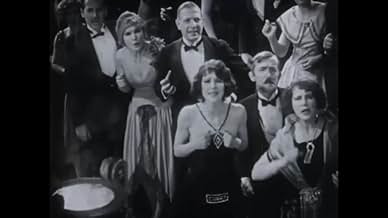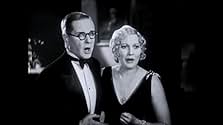This is one of those Silent horror films I thought I'd only get to read about in reference books, as it was considered lost – until an Italian print, albeit extremely faded, eventually surfaced. Actually, the version I watched has been renamed Satan'S STAIRWELL – which I assume is a literal translation of the film's Italian title – while the intertitles themselves have been translated back into English (and which tend to remain on screen for an inordinate length of time)! Of course, one is happy to take such rare films in any form they may come
Typical of many latter-day Silents, the horror element here is mingled with intermittent doses of comedy – though not so much as in, say, THE CAT AND THE CANARY (1927), with which it shares leading man Creighton Hale in a similar role; he's partnered in this case with the popular and tragic Thelma Todd, who comes off somewhat better than Laura La Plante from the earlier film (from the cast, I also recognized Sojin and the ubiquitous Angelo Rossitto – but had no idea that 'The Spider' was played by Sheldon Lewis, who had over-acted so horrendously in the rival 1920 version to the John Barrymore DR. JEKYLL AND MR. HYDE). Also, like THE CAT AND THE CANARY, Christensen's film boasts a very striking visual style highlighted by inventive – and impressive – art direction, camera-work (simulating, for instance, the motion of going up the various floors of the main 'haunted house' set), lighting and editing (at one point, a door opening is quickly followed by a succession of gunshots, only to be revealed as the hero engaged in target practice).
What makes the film unique, perhaps, is its relentless parade of grotesques (a dwarf, a gorilla, a pock-marked cripple, an ape-man, a sinister Oriental, an androgynous servant, etc.) and assorted maidens (either scantily-clad hostages or perverted followers of a satanic cult); all of this gives the film a creepy overall tone which is not easy to shake off and has seldom been replicated with such gusto: the climactic orgy is downright chilling – a veritable Pre-Code moment – with its suggestive flagellation (anticipating a famous scene in THE SIGN OF THE CROSS [1932]) and satanic audience (though the Devil himself is depicted as nothing more scary than a mysterious figure in a hood!). Which brings us to the cop-out ending that's moralistic (in a good-natured way) but not really unexpected for a horror film of its time (think London AFTER MIDNIGHT [1927]) and, in any case, shouldn't be seen as too much of a let-down considering just how satisfying – and immensely enjoyable – the lead-up to it has been!
In conclusion, I wanted to comment on Christensen's Hollywood career: one may think it a shame that he seems to have gotten stuck in the 'old dark house' subgenre – what with his having directed two more of those, THE HAUNTED HOUSE (1928) and HOUSE OF HORROR (1929), both also featuring Todd and both of which, unfortunately cannot be assessed due to unavailability – but, the fact remains that he seriously bungled his one chance at working with the great Lon Chaney on the hoary and ill-suited Russian Revolution melodrama, MOCKERY (1927). However, while his work may have been overshadowed by that of other European directors employed in Hollywood during the final days of the Silent era, this viewing of SEVEN FOOTPRINTS TO Satan more than restores his reputation as a visual stylist and someday I would love to be able to check out his only remaining surviving film, the intriguing THE DEVIL'S CIRCUS (1926)


































